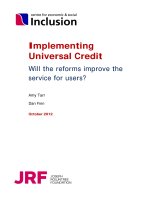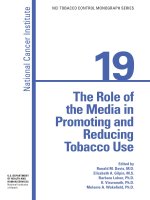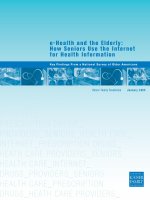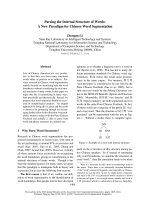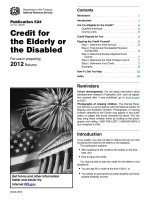Shifting the paradigm for promoting appropriate antibiotic use
Bạn đang xem bản rút gọn của tài liệu. Xem và tải ngay bản đầy đủ của tài liệu tại đây (263.53 KB, 23 trang )
SHIFTING THE PARADIGM
FOR PROMOTING
APPROPRIATE ANTIBIOTIC
USE
Hoàng Thị Hằng
ALEXANDER FLEMING
1928- PENICILLIN
Is penicillin discovery one of the most wonderful
things in the 20th century?
/ˌæntibaɪˈɒtɪk/
1.
2.
3.
What is “antibiotic”?
When to use antibiotics?
When not to use antibiotics?
WARM UP
Definition of “antibiotic overuse”, “antibiotic
underuse”
2.
What are some consequences of antibiotic
overuse?
Resistance, weaker immune system need to find
new antibiotics time &money
3.
What are some solutions to antibiotic overuse?
1.
TERMS
1.
2.
3.
4.
5.
6.
7.
8.
9.
10.
11.
Diagnostic strategies
Diagnostic algorithm
Clinical practice guidelines
Ambulatory care
Perspective
Clinical care
Clinical outcome; patient-centered
outcome
Clinical algorithm
Clinical decision making
Clinical settings
Clinical syndrome
1.
2.
3.
4.
5.
6.
7.
8.
Paradigm shift
Magic bullet strategies
Diagnostic uncertainty
Stakeholder
Variable reduction
Sustainable reduction
Judicious antibiotic use
Barrier
VOCABULARY
Persistent (a) continuing for a long time
Famine is a persistent problem in many parts of the
world
2.
Ambulatory care= outpatient care
The studies highlighted the persistent problem of
poor quality of antibiotic use in ambulatory care.
3.
Diagnostic (a) related to identifying sth
4.
Heterogeneity /ˌhetərədʒəˈniːəti/ state of many
people
There is much heterogeneity among these
institutions.
5.
attenuate (v) to make sth weaker or less
effective (The drug attenuates the effects of the
virus)
6.
Algorithm(n) set of rules that must be followed
1.
7. Triage (n)
The triage normally takes a few minutes.
8. Feasible (a) possible
9. Scalabitily /ˌskeɪləˈbɪləti/ possibility to adapt to sth
The strategies are feasible interventions with established
scalability.
10. Incorporate (v) to include sth
Previous studies are important to incorporate in strategies
for reducing antibiotic use.
11. Stakeholder (n) a member of
12. Recalcitrance (n) the quality of being difficult to
control.
They stated the recalcitrant nature of antibiotic
prescribing practices in the US.
13. trade-off (n) the act of balancing 2 things (There
is a trade-off between the benefits of the drug and
the risk of side effects.)
14. Align (v) change sth
15. Judicious (a) careful and sensible
QUESTIONS
What did the 2 studies find out?
A- Litvin et all
B- Nakhoul and Hickner
2. What is the persistent problem? What
did the investigators try to do? Explain the
use of antibiotics for ARIs.
3. What are 3 broad issues of strategies to
reduce unsuitable antibiotic prescription?
1.
4. What are the negative aspects from
the study by Litvin and Nakhoul?
5. What problems of antibiotic overuse
did Shortell and damschroder find
out? What is the role of local context?
What should be done?
6. What is the conclusion?
What did the 2 studies find out?
A- Litvin et all
B- Nakhoul and Hickner
1.
A- not reduce use of antibiotics overall/
specific target conditions
B- more than 50% of patients with +
rapid test & DNA test
2. What is the persistent problem? What
did the investigators try to do? Explain the
use of antibiotics for ARIs.
A- poor quality of antibiotic use in
ambulatory care
B- focus on reducing + inappropriate
overuse of antibiotics (non-bacterial, selflimited infections)
+inappropriate
underuse not use antibiotic when
necessary
3. What are 3 broad issues of
strategies to reduce unsuitable
antibiotic prescription?
A- heterogeneity of clinical settings
B- importance of multidimentional
interventions
C- requirement for implementation
strategies
4. What are the negative aspects from
the study by Litvin and Nakhoul?
5. What problems of antibiotic overuse
did Shortell and damschroder find
out? What is the role of local context?
What should be done?
6. What is the conclusion?
4. What are the negative aspects from
the study by Litvin and Nakhoul?
Not include components related to
patient attitudes and expectations for
antibiotics
Patient and provider educational
interventions
Social marketing campaigns success
in health promotions & behavior
change
5. What problems of antibiotic overuse
did Shortell and damschroder find
out? What is the role of local context?
What should be done?
Problems
Lack of connection between changing
behavior and benefits of change
Lack of organization readiess to
change
Low compatibility with exiting values
and social norms of staff & pts.
Local context success of
Diagnostic algorithms
Educational programs
Decision support tools
What should be done
Individualize treatment
Strategies with local adaptation of
interventions

